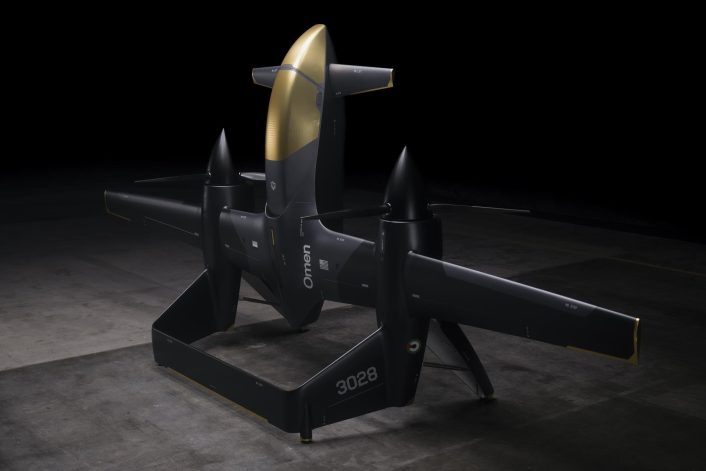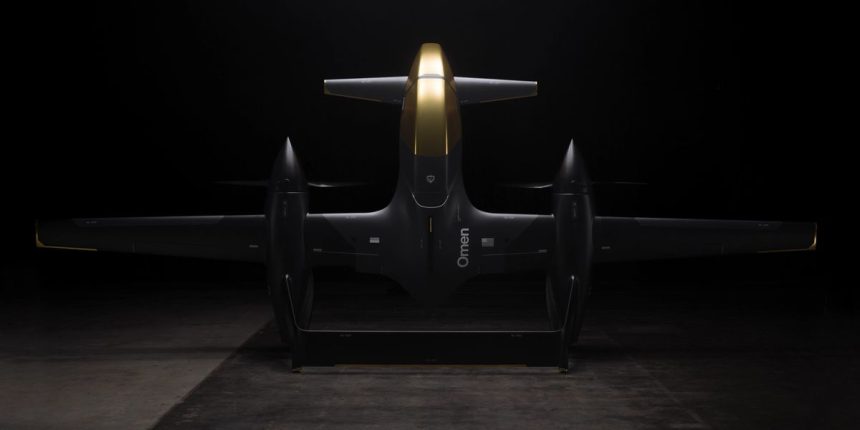Anduril and EDGE will collaborate on Omen, a hybrid-powered, tailsitter UAS which aims to deliver long endurance and high payload in a compact, runway-free platform.
Anduril Industries and UAE state-owned EDGE Group have announced a production alliance to field Omen, a new hover-to-cruise, runway-independent Autonomous Air Vehicle (AAV) that the partners say combines the endurance and payload of much larger aircraft with the logistics simplicity of a compact Group-3 platform. The announcement, formalized in the EDGE–Anduril Production Alliance, includes an initial UAE purchase of 50 systems and a plan to take the aircraft into full-rate production by the end of 2028.
Omen AAV
Omen is designed as a tailsitter, able to take off and land vertically while resting on its tail, transitioning to conventional, airplane-style cruise flight once in the air. Anduril describes it as “a hover-to-cruise Autonomous Air Vehicle (AAV) that packs the endurance, payload, and mission flexibility of much larger airplanes into a novel runway-independent group 3 platform.”
“Its payload capacity is ‘three to five times’ that of traditional systems in this category.”
— Shane Arnott, Senior Vice-President at Anduril for the Maneuver Dominance division
The design features what has been described as sailplane-style wings, canards, and twin-boom nacelles that feed into a high horizontal tail, says Aviation Week. The configuration is intended to deliver the cruise efficiency of a fixed-wing machine while preserving a VTOL ability to operate from decks, beaches or austere clearings without runways.
— Anduril Industries (@anduriltech) November 12, 2025
Anduril says Omen collapses to less than half its assembled size and can be unpacked, assembled and launched by a two-person team in minutes, and is thus explicitly optimized for low-logistics expeditionary use. Additionally, the company says the drone can easily and rapidly swap payloads, from EO/IR gimbals to advanced sensing, communication, and effects-enabling systems.
Propulsion and Funding
Development of Omen has been underway for several years, however Anduril’s engineers faced propulsion limits on a demonstrator tested in 2019, reported Aviation Week. Anduril executives told reporters that a breakthrough came through work on hybrid propulsion concepts and collaboration with Archer Aviation, which develops hybrid-electric VTOL systems.

“We hit a wall when it came to propulsion technologies. … So we’ve been working very diligently over the last few years, looking at new systems, and in particular series hybrid tech, and working with companies like Archer.”
— Shane Arnott, Senior Vice-President at Anduril for the Maneuver Dominance division
The powerplant will be a version of the hybrid propulsion system developed by Archer, however no details have been released so far. Judging by the renderings released with the announcement of the joint venture, the powerplant will likely feature a thermal engine in a central location, where an air inlet is located (behind a fake cockpit), with electric motors in the nacelles on which the propellers are installed.
Anduril has stated that it has invested roughly $850 million of its internal funds in autonomy and Group-3 VTOL development, including also the funding used by Omen. EDGE will provide about $200 million for joint development and local manufacturing capacity in the UAE.
Mission sets and modularity
The two companies position Omen as a deliberately dual-use system, able to be employed both in military and civilian settings. Military missions include maritime domain awareness, long-range overland surveillance, contested logistics support, communications relay and enabling electronic payloads, while civilian commercial and humanitarian applications include search-and-rescue, disaster recovery and network restoration.

Anduril emphasizes an open, modular architecture so payloads, ranging from EO/IR gimbals to high-power electronic sensors or logistics pods, can be swapped rapidly to match the task. This architecture would also allow quick and easy modifications and upgrades to the aircraft.
In the reporting by Breaking Defense and Aviation Week, senior Anduril engineers argued the platform occupies a capability niche at the high end of Group-3 UAS, carrying more payload and range than conventional systems in the category, and therefore challenging roles traditionally assigned to much larger, crewed special-mission aircraft.
“We believe we’re onto something and … this is less about disrupting Group 3. This is more about disrupting current maritime patrol, special mission aircraft, much bigger systems. That’s what we’re going after,” said Shane Arnott, Senior Vice President of Programs and Engineering at Anduril.
Industrial Footprint
The EDGE–Anduril Production Alliance will establish local production, sales and sustainment in the UAE, with an in-region, 50,000-square-foot Research & Development and virtual-simulation center to support engineering, integration and testing. The initial UAE order of 50 systems would anchor early production and supply-chain development.

Later on, systems for other customers will be produced in the UAE, while U.S. orders would be manufactured at Anduril’s Arsenal-1 facility in Ohio, explains the press release. Edge and Anduril stressed that activities will proceed subject to U.S. and UAE approvals, and both are finalizing the required arrangements.
The EDGE–Anduril Production Alliance highlights an increasingly pragmatic approach to allied industrial partnerships, with co-investment in local capability, shared software stacks and coordinated production to speed fielding and provide regional sovereign supply chains. A similar approach is being adopted by other U.S. companies to bring production of their unmanned aircraft to the European and Asian markets.
For EDGE, the press release says the joint venture brings access to Anduril’s continuously updated Lattice software platform. For Anduril, the joint venture creates a trusted production base in the Middle East for regional customers. The companies further note they share a philosophy: “move fast, invest ahead of need, and deliver real capability.”









